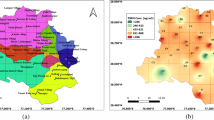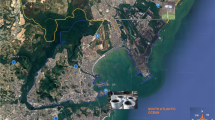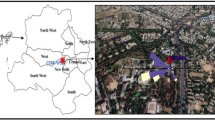Abstract
Settleable particulate matter (SPM), especially coarser particles with diameters greater than 10 μm, has been found culprit of high deposition rates in cities affected by hinterland industrial activities. This is the case of Metropolitan Region of Vitoria (MRV), Espirito Santo, Brazil where industrial facilities are located within the urban sprawl and building constructions are intense. Frequent population complaints to the environmental protection agency (IEMA) throughout the years have triggered monitoring campaigns to determine SPM deposition rates and source apportionment. Eight different locations were monitored throughout the MRV, and SPM was quantified and chemically characterized. Sources profiles were defined either by using US EPA SPECIATE data or by experimental analysis. Atmospheric fallout in the MRV ranged between 2 and 20g/(m2 30-day), with only one monitoring station ranging from 6–10 g/(m2 30-day). EC, OC, Fe, Al, and Si were found the main constituents of dry deposition in the region. Source apportionment by the chemical mass balance (CMB) model determined that steel and iron ore pelletizing industries were the main contributor to one of the eight locations whereas resuspension, civil construction, and vehicular sources were also very important contributors to the other stations. Quarries and soil were also considered expressive SPM sources, but at the city periphery. CMB model could differentiate contributions from six industrial source groups: thermoelectric; iron ore, pellet, and pellet furnaces; coal coke and coke oven; sintering, blast furnace, and basic oxygen furnace; and soil, resuspension, and vehicles. However, the CMB model was unable to differentiate between iron ore and pellet stockpiles which are present in both steel and iron ore pelletizing industries. Further characterization of source and SPM might be necessary to aid local authorities in decision-making regarding these two industrial sources.







Similar content being viewed by others
References
Alves MR, Trindade CC, Queiroz SQ, Mathias SMH, Entringer SMJ (2006) Análise da percepção ambiental da população da Grande Vitória à poeira sedimentável. In: VIII Simpósio Ítalo Brasileiro de Engenharia Sanitária e Ambiental – SIBESA. Fortaleza/CE – Brasil. Resumo dos trabalhos técnicos “Mudanças globais: desafios para o saneamento ambiental”. Rio de Janeiro: Associação Brasileira de Engenharia Sanitária e Ambiental, p.339
Alves DD, Osório DMM, Rodrigues MAS et al (2015) Concentrations of PM2.5-10 and PM2.5 and metallic elements around the Schmidt stream area, in the Sinos River basin, southern Brazil. Brazilian J Biol 75:43–52. doi:10.1590/1519-6984.00113suppl
Amato F, Alastuey A, De La Rosa J et al (2014) Trends of road dust emissions contributions on ambient air particulate levels at rural, urban and industrial sites in southern Spain. Atmos Chem Phys 14:3533–3544. doi:10.5194/acp-14-3533-2014
ASTM (2004) ASTM D-1739: standard test method for collection and measurement of dustfall (settleable particulate matter)
ASTM (2014) ASTM C136—standard test method for sieve analysis of fine and coarse aggregates. West Conshohocken
Bi X, Feng Y, Wu J et al (2007) Source apportionment of PM10 in six cities of northern China. Atmos Environ 41:903–912. doi:10.1016/j.atmosenv.2006.09.033
Bobbink R, Hicks K, Galloway J et al (2010) Global assessment of nitrogen deposition effects on terrestrial plant diversity: a synthesis 20:30–59. doi: 10.1890/08-1140.1
Boonyatumanond R, Wattayakorn G, Togo A, Takada H (2006) Distribution and origins of polycyclic aromatic hydrocarbons (PAHs) in riverine, estuarine, and marine sediments in Thailand. Mar Pollut Bull 52:942–956. doi:10.1016/j.marpolbul.2005.12.015
Chen P, Wang T, Hu X, Xie M (2015) Chemical mass balance source apportionment of size-fractionated particulate matter in Nanjing. China Aerosol Air Qual Res. doi:10.4209/aaqr.2015.03.0172
Cheng Y, Lee S, Gu Z et al (2015) PM2.5 and PM10–2.5 chemical composition and source apportionment near a Hong Kong roadway. Particuology 18:96–104. doi:10.1016/j.partic.2013.10.003
Chin M, Jacob DJ, Gardner GM et al (1996) A global three-dimensional model of tropospheric sulfate. J Geophys Res Atmos 101:18667–18690. doi:10.1029/96JD01221
Chow JC, Watson JG, Frank N, Homolya J (1998) Guideline on speciated particulate monitoring. Reno
Chu C-C, Fang G-C, Chen J-C, Yang I-L (2008) Dry deposition study by using dry deposition plate and water surface sampler in Shalu, central Taiwan. Environ Monit Assess 146:441–451. doi:10.1007/s10661-007-0090-8
Chung W, Chen Q, Osammor O et al (2012) Characterisation of particulate matter on the receptor level in a city environment. Environ Monit Assess 184:1471–1486. doi:10.1007/s10661-011-2054-2
Cirera L, Rodríguez M, Giménez J et al (2009) Effects of public health interventions on industrial emissions and ambient air in Cartagena, Spain. Environ Sci Pollut Res 16:152–161. doi:10.1007/s11356-008-0091-3
Coulter CT (2004) EPA-CMB8.2 users manual, report EPA-452/R-04-011
Crilley LR, Lucarelli F, Bloss WJ et al (2017) Source apportionment of fine and coarse particles at a roadside and urban background site in London during the 2012 summer ClearfLo campaign. Environ Pollut 220:766–778. doi:10.1016/j.envpol.2016.06.002
Davidson CI, Lindberg SE, Schmidt JA et al (1985) Dry deposition of sulfate onto surrogate surfaces. J Geophys Res 90:2123. doi:10.1029/JD090iD01p02123
de Moraes RJB, Costa DB, Araújo IPS (2016) Particulate matter concentration from construction sites: concrete and masonry works. J Environ Eng 142:5016004. doi:10.1061/(ASCE)EE.1943-7870.0001136
de Souza JB, Reisen VA, Santos JM, Franco GC (2014) Principal components and generalized linear modeling in the correlation between hospital admissions and air pollution. Rev Saude Publica 48:451–458. doi:10.1590/S0034-8910.2014048005078
Duce RA, Liss PS, Merrill JT et al (1991) The atmospheric input of trace species to the world ocean. Glob Biogeochem Cycles 5:193–259. doi:10.1029/91GB01778
Espirito Santo (2013) Decreto N. 3463-R, 16 de Dezembro de 2013. Estabelece novos padrões de qualidade do ar e dá providências correlatas. Vitória
European Commission (2008) Directive 2008/50/EC of the European Parliament and of the Council of 21 May 2008 on ambient air quality and cleaner air for Europe
Fang G-C, Wu Y-S, Rau J-Y, Huang S-H (2006) Characteristic study of dry deposition, concentration, compositions for particulates mass and ionic species during summer and autumn season at a traffic sampling site. Environ Monit Assess 122:259–273. doi:10.1007/s10661-005-9179-0
Fang G-C, Huang Y-L, Huang J-H, Liu C-K (2012) Dry deposition of Mn, Zn, Cr, cu and Pb in particles of sizes of 3μm, 5.6μm and 10μm in central Taiwan. J Hazard Mater 203:158–168. doi:10.1016/j.jhazmat.2011.11.098
Farfel MR, Orlova AO, Lees PSJ et al (2005) A study of urban housing demolition as a source of lead in ambient dust on sidewalks, streets, and alleys. Environ Res 99:204–213. doi:10.1016/j.envres.2004.10.005
Fenn ME, Haeuber R, Tonnesen GS et al (2003) Nitrogen emissions, deposition, and monitoring in the Western United States. Bioscience 53:391. doi:10.1641/0006-3568(2003)053[0391:NEDAMI]2.0.CO;2
Fowler D, Pilegaard K, Sutton MA et al (2009) Atmospheric composition change: ecosystems–atmosphere interactions. Atmos Environ 43:5193–5267. doi:10.1016/j.atmosenv.2009.07.068
Hasan SA, Fariduddin Q, Ali B et al (2009) Cadmium: toxicity and tolerance in plants. J Environ Biol 30:165–174
Holsen TM, Noll KE (1992) Dry deposition of atmospheric particles: application of current models to ambient data. Environ Sci Technol 26:1807–1815. doi:10.1021/es00033a015
Hu T, Li X, Dong J et al (2006) Morphology and elemental composition of dustfall particles inside emperor qin’s terra-cotta warriors and horses museum. China Particuology 4:346–351. doi:10.1016/S1672-2515(07)60288-7
Hu Y, Balachandran S, Pachon JE et al (2014) Fine particulate matter source apportionment using a hybrid chemical transport and receptor model approach. Atmos Chem Phys 14:5415–5431. doi:10.5194/acp-14-5415-2014
Khan MF, Hirano K, Masunaga S (2010) Quantifying the sources of hazardous elements of suspended particulate matter aerosol collected in Yokohama, Japan. Atmos Environ 44:2646–2657. doi:10.1016/j.atmosenv.2010.03.040
Khan MF, Hirano K, Masunaga S (2012) Assessment of the sources of suspended particulate matter aerosol using US EPA PMF 3.0. Environ Monit Assess 184:1063–1083. doi:10.1007/s10661-011-2021-y
Koulouri E, Saarikoski S, Theodosi C et al (2008) Chemical composition and sources of fine and coarse aerosol particles in the eastern Mediterranean. Atmos Environ 42:6542–6550. doi:10.1016/j.atmosenv.2008.04.010
Kumar AV, Patil R, Nambi KS (2001) Source apportionment of suspended particulate matter at two traffic junctions in Mumbai, India. Atmos Environ 35:4245–4251. doi:10.1016/S1352-2310(01)00258-8
Kumar KR, Narasimhulu K, Balakrishnaiah G, Reddy BSK, Gopal KR, Reddy RR, Reddy LSS, Moorthy KK, Babu SS, Dutt CBS (2011) Spatial heterogeneities in aerosol properties over Bay of Bengal inferred from ship–borne and MODIS observations during ICARB–W cruise campaign: Implications to radiative forcing. Atmos Environ, 45:404–412
Lee S, Liu W, Wang Y et al (2008) Source apportionment of PM2.5: comparing PMF and CMB results for four ambient monitoring sites in the southeastern United States. Atmos Environ 42:4126–4137. doi:10.1016/j.atmosenv.2008.01.025
Lestari P, Oskouie AK, Noll KE (2003) Size distribution and dry deposition of particulate mass, sulfate and nitrate in an urban area. Atmos Environ 37:2507–2516. doi:10.1016/S1352-2310(03)00151-1
Lin JJ, Noll KE, Holsen TM (1994) Dry deposition velocities as a function of particle size in the ambient atmosphere. Aerosol Sci Technol 20:239–252. doi:10.1080/02786829408959680
Lue YL, Liu LY, Hu X et al (2010) Characteristics and provenance of dustfall during an unusual floating dust event. Atmos Environ 44:3477–3484. doi:10.1016/j.atmosenv.2010.06.027
MADS (1973) Ley Nacional 20.284. Contaminación Atmosférica. Argentina
Matsumoto K, Tominaga S, Igawa M (2011) Measurements of atmospheric aerosols with diameters greater than 10 μm and their contribution to fixed nitrogen deposition in coastal urban environment. Atmos Environ 45:6433–6438. doi:10.1016/j.atmosenv.2011.07.061
Mazzei F, D’Alessandro A, Lucarelli F et al (2008) Characterization of particulate matter sources in an urban environment. Sci Total Environ 401:81–89. doi:10.1016/j.scitotenv.2008.03.008
Melo MM, Santos JM, Frere S et al (2015) Annoyance caused by air pollution: a comparative study of two industrialized regions. World Acad Sci Eng Technol Int J Medical Heal Biomed Bioeng Pharm Eng 9:182–187
MMA (2011) 1o Inventário Nacional de Emissões Atmosféricas por Veículos Automotores Rodoviários
Nam JJ, Thomas GO, Jaward FM et al (2008) PAHs in background soils from Western Europe: influence of atmospheric deposition and soil organic matter. Chemosphere 70:1596–1602. doi:10.1016/j.chemosphere.2007.08.010
Pöschl U (2005) Atmospheric aerosols: composition, transformation, climate and health effects. Angew Chem Int Ed Engl 44:7520–7540. doi:10.1002/anie.200501122
Samara C (2005) Chemical mass balance source apportionment of TSP in a lignite-burning area of Western Macedonia, Greece. Atmos Environ 39:6430–6443. doi:10.1016/j.atmosenv.2005.07.027
Samara C, Voutsa D (2005) Size distribution of airborne particulate matter and associated heavy metals in the roadside environment. Chemosphere 59:1197–1206. doi:10.1016/j.chemosphere.2004.11.061
Sardans J, Rivas-Ubach A, Peñuelas J (2012) The C:N:P stoichiometry of organisms and ecosystems in a changing world: a review and perspectives. Perspect Plant Ecol Evol Syst 14:33–47. doi:10.1016/j.ppees.2011.08.002
Sarkar S, Khillare PS (2013) Profile of PAHs in the inhalable particulate fraction: source apportionment and associated health risks in a tropical megacity. Environ Monit Assess 185:1199–1213. doi:10.1007/s10661-012-2626-9
Segura FR, Nunes EA, Paniz FP et al (2016) Potential risks of the residue from Samarco’s mine dam burst (Bento Rodrigues, Brazil). Environ Pollut. doi:10.1016/j.envpol.2016.08.005
Sharma RK, Agrawal M, Marshall FM (2008) Atmospheric deposition of heavy metals (cu, Zn, cd and Pb) in Varanasi City, India. Environ Monit Assess 142:269–278. doi:10.1007/s10661-007-9924-7
Slinn WGN (1983) Precipitation scavenging, in: atmospheric sciences and power production. Washington
Srivastava A, Jain VK (2007) Size distribution and source identification of total suspended particulate matter and associated heavy metals in the urban atmosphere of Delhi. Chemosphere 68:579–589. doi:10.1016/j.chemosphere.2006.12.046
Thurston GD, Ito K, Lall R (2011) A source apportionment of U.S. fine particulate matter air pollution. Atmos Environ 45:3924–3936. doi:10.1016/j.atmosenv.2011.04.070
Turpin BJ, Saxena P, Andrews E (2000) Measuring and simulating particulate organics in the atmosphere: problems and prospects. Atmos Environ 34:2983–3013
USEPA (2009) SPECIATE 4.2—speciation database development documentation
Vallack H, Shillito D (1998) Suggested guidelines for deposited ambient dust. Atmos Environ 32:2737–2744. doi:10.1016/S1352-2310(98)00037-5
Wang J, Zhang J, Liu Z et al (2017) Characterization of chemical compositions in size-segregated atmospheric particles during severe haze episodes in three mega-cities of China. Atmos Res 187:138–146. doi:10.1016/j.atmosres.2016.12.004
Watson JG, Fujita E, Chow JC, Zielinska B (1998) Northern front range air front air quality study final report. Nevada
Yatkin S, Bayram A (2010) TSP, PM depositions, and trace elements in the vicinity of a cement plant and their source apportionments using chemical mass balance model in Izmir, Turkey. Environ Monit Assess 167:125–141. doi:10.1007/s10661-009-1036-0
Zhou M, He G, Fan M et al (2015) Smog episodes, fine particulate pollution and mortality in China. Environ Res 136:396–404. doi:10.1016/j.envres.2014.09.038
Acknowledgements
The authors would like to acknowledge the support of the Espírito Santo Research Foundation (Fundação de Amparo à Pesquisa do Espírito Santo—FAPES), Brazilian Federal Agency for the Support and Evaluation of Graduate Education (Coordenação de Aperfeiçoamento de Pessoal de Nível Superior—CAPES) and National Council for Scientific and Technological Development (Conselho Nacional de Desenvolvimento Científico e Tecnológico—CNPq) (Brazilian government agencies for technology development and scientific research).
Author information
Authors and Affiliations
Corresponding author
Additional information
Responsible editor: Gerhard Lammel
Rights and permissions
About this article
Cite this article
Santos, J.M., Reis, N.C., Galvão, E.S. et al. Source apportionment of settleable particles in an impacted urban and industrialized region in Brazil. Environ Sci Pollut Res 24, 22026–22039 (2017). https://doi.org/10.1007/s11356-017-9677-y
Received:
Accepted:
Published:
Issue Date:
DOI: https://doi.org/10.1007/s11356-017-9677-y




